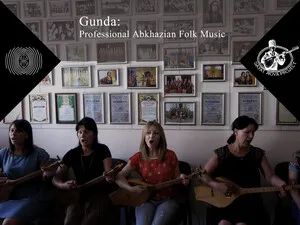Abkhazian folk music is the traditional music of the Abkhaz people of the western Caucasus, shaped by mountainous landscapes, coastal life on the Black Sea, and communal rituals. It is predominantly vocal and highly polyphonic, featuring close-interval harmonies, sustained drones, call-and-response textures, and powerful choral delivery.
Songs encompass epic narrative cycles (including Nart sagas), wedding and dance songs, heroic toasts, laments, and work songs. Melodies often move within narrow ambitus, emphasize modal centers, and employ ornamental turns, while rhythms range from free declamation to driving asymmetric dance meters. Instrumental accompaniment appears in specific contexts (e.g., frame drums, reed flutes, later accordion and fiddle), but unaccompanied multi-part singing remains the core sound.
Texts are primarily in the Abkhaz language and highlight community ethics, hospitality, bravery, and attachment to homeland. The performance is social and participatory, with antiphonal exchanges, handclaps, and circle dances reinforcing a strong communal ethos.
Abkhazian folk music developed as an orally transmitted village tradition rooted in everyday life—harvests, weddings, communal dances, and heroic storytelling. Its core traits—polyphonic vocal textures, drones, and call-and-response—belong to the wider Caucasian polyphonic zone but are shaped by Abkhaz language prosody and local ritual practice.
Before the 19th century, songs circulated through clans and villages without formal notation. Communal leaders, chant-leaders, and skilled improvisers held key roles in maintaining repertory and guiding polyphonic entries, often tied to epic cycles (including Nart narratives), toasting traditions, and seasonal rites.
During the Soviet era, state ensembles, folklore festivals, and radio archives codified and staged traditional songs. Choral arrangements, staged dance suites, and mixed vocal–instrumental formats appeared, while field recordings documented village styles. Despite stylization, many local performance practices—drones, parallel seconds, responsorial cues—remained audible.
A sizable Abkhaz diaspora in Turkey and elsewhere preserved songs, influencing instrument choices (e.g., accordion) and creating variants that reflect contact with Ottoman/Turkish and broader Black Sea musical life. Diaspora festivals and community choirs helped sustain repertory during periods of political upheaval.
Post-1990s, community ensembles, cultural centers, and educational projects renewed interest in local polyphony, children’s choirs, and dance troupes. Modern recordings typically favor natural choral timbre, minimal amplification, and live, communal acoustics. While some fusion projects exist, the tradition’s core identity remains communal, unaccompanied, and polyphonic.





%2C%20Cover%20art.webp)
)%2C%20Cover%20art.webp)

